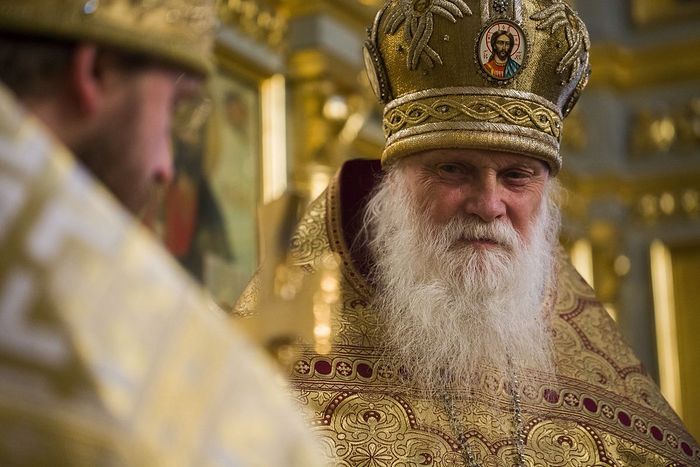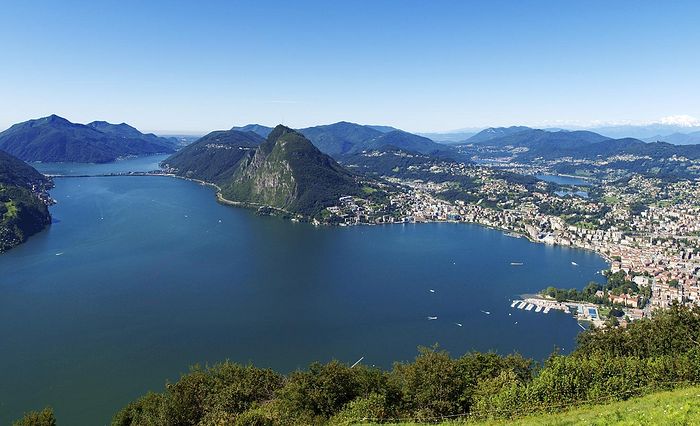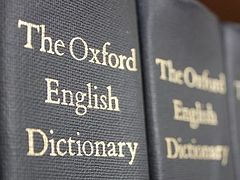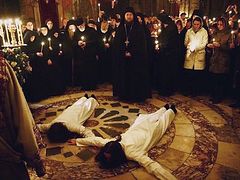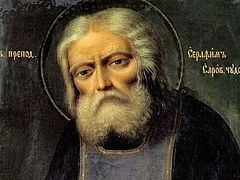Schema-Archimandrite Gabriel (Bunge) is the abbot of the Monastery of the Exaltation of the Cross located near Lugano, Switzerland. He is a well-known patrologist, theologian and an author of a number of books, which have been translated into numerous European languages.
In our continued conversation, Fr. Gabriel answers the following important questions regarding the history of Christianity and its contemporary status: What are the reasons for the schism between the Orthodox East and Catholic West, and can it be overcome? Would the creation of monastic orders be appropriate for the Orthodox Church? What kind of education must the monks have? How should Christians maintain the proper spiritual frame of mind?
—In Catholicism, there are a great number of monastic orders and each of them has a certain mission, while in Orthodoxy, we have only various monastic vows or monasteries with various statutes. For example, we have scholarly monastics, administrative monastics, etc. Do you think it would be appropriate for the Orthodox Church to create monastic orders that would be involved in various types of activities, so that the graduates of religious establishments could select specific areas to serve the Church based on their abilities or inclinations?
—Monasticism does not exist for any specific purposes related to this world. To quote an anonymous author of The History of Egyptian Monks (fourth century), “From the very beginning, the purpose of monasticism was following Christ in the desert, singing hymns and psalms and waiting for our Lord to come.” This seeming “uselessness” makes monasticism free from any services within the Church structure. The Orthodox Church preserved this original trait of monasticism as well as its many other aspects.
Although it had the same roots, Western monasticism evolved in a totally different manner. Canonically, there are only a few monastic orders in Catholicism: Benedictines with their various branches (Cistercians, Trappists, Camaldolese, etc.) and, for example, Carthusians. A great number of various religious “orders” was formed in the middle ages. In modern times, the division into “the institutes of consecrated life” continued. All these various forms of “consecrated life” met various needs of the Church.
Such diversity obviously offers certain advantages. However, its main disadvantage is that the true monastic life is sidelined. I’m just repeating the words of Benedictine abbots I know who say that regretfully the church hierarchy struggles with the idea that monasteries exist. It should be noted that the Catholic church is managed by secular clergy (who have taken the vow of chastity), and this clergy makes it very different from all other “Eastern” (Byzantine or Pre-Chalcedonian churches.
Another disadvantage is the institutionalization of the entities that were originally created to perform specific tasks, such as fighting heresy, preaching among people, carrying out missionary work, educating young people and taking care of the sick and children. This is the trend that facilitates continued existence of such institutions even when they are no longer needed, since some of these tasks are now performed by the government.
I believe that the Orthodox Church is well-informed, and that is why it is not going the way of the Latin Church, firmly maintaining the integrity of monastic life! Orthodox monasticism is in fact as multi-faceted as the Western religious life, and there is no tendency to institutionalize its various aspects, which are often determined by the history of the monastery and the legacy of the saint who founded it. Even though there is a great number of monasteries, the monks can always move from one monastery to another.
I’ll give you an example. A monk may start his monastic life in a monastic community (cenobium) and then move to a skete (like I did). Afterwards, he may become a very high ranking official in the Church (a bishop or even a patriarch) and by the end of his life become a hermit. He can do all of this without leaving one order and joining another, which requires starting from the very beginning every time and becoming a novice like it happens in the Catholic Church.
Habits of monks of various orders: 1—Benedictine; 2—Carthusian; 3—Cistercian; 4—Dominican, 5—Franciscan
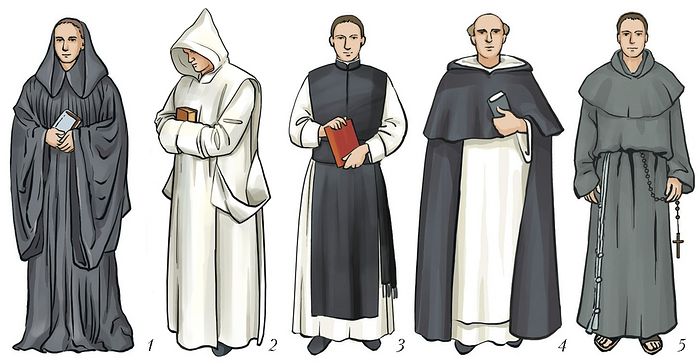 Habits of monks of various orders, from left to right: Benedictine, Carthusian, Cistercian, Dominican, Franciscan.
Habits of monks of various orders, from left to right: Benedictine, Carthusian, Cistercian, Dominican, Franciscan. Disruption of religious life in various “orders” that were characteristic for the Catholic West led to many undesirable consequences that ultimately made it weaker. For example, since every religious order had (or claimed to have) its own specific “spirituality”, their monks could not even study at the same universities and each order had to have its own university! Fortunately, after the Second Vatican Council, these rules were discontinued.
That is why I believe that we shouldn’t imitate the Catholic religious orders not only because they reflect Catholic centralized (papal!) and globalized ecclesiology, but because it is impractical. The Orthodox ecclesiology is different, it still focuses on local churches united in Patriarchates. The Catholic orders were formed in the West in the Middle Ages because local churches (dioceses) could no longer integrate organized religious movements whose activities were beyond the scope of work carried out by dioceses. On the other hand, the old abbeys of true monks did not create such problems because they were based in certain locations and maintained by their abbots. Rome (papacy) responded to this challenge in the usual way: it made these new orders directly subordinate to itself. This is how Rome deals with so called “movements” today too.
The versatile structure of the Catholic Church undoubtably gives it a greater degree of mobility and freedom, but this happens at the expense of local churches. As a result, greater uniformity is achieved at the cost of losing the original spiritual richness of monastic life. As mentioned above, the classic monasticism was sidelined and almost lost its connection to the Church, while in Orthodoxy, monasticism is still at the heart of the Church and the believers.
That is why there are no reasons to imitate this unmistakably Western (Catholic) evolution, that “classical” western monks themselves describe as “emasculation”. I can go on about this continuing emasculation and its dangerous consequences, but I don’t want to take more of your time.
On the education of monks
—Do you think it is important for scholarly inclined monks to receive religious education, study foreign languages, and attend western universities?
—This question is related to several important issues that I know are widely discussed in the Russian Orthodox Church. That is why I would like to express my own opinion based on my personal experience, without claiming that this opinion is applicable to everybody and every situation.
Every monk, whether a monk living modestly in his monastery or an educated Church official, must have a good spiritual education. I think this is indisputable. By “spiritual education” I don’t mean higher education, but a serious initiation into the spiritual Tradition of the Orthodox Church. Otherwise, how can he overcome the many temptations spread by satan? If monks only worked—physically in their monasteries or intellectually in church offices—their lives would be unproductive and useless.
As far as the study of foreign languages is concerned, I believe that it is useful for those who wish to develop relations with other Orthodox Churches, theologians or people from non-Orthodox countries. This includes missionaries or priests working in a diaspora. Personally, I learned only the languages that I needed to study ancient texts or to live in other countries, at first in Belgium, then in the Italian part of Switzerland.
The issue of attending western universities is important for only a small group of “monastic scholars”. Again, I would recommend such education only to those who had already graduated from Orthodox universities. It would be good for the monks whose faith is already strong, when they decide that they need a more profound knowledge in specific subjects. In the modern globalized world Orthodoxy must know what “others” are thinking.
People today travel a lot and meet the Christians of other denominations both in their countries and abroad. That is why it is useful to be well-informed about their way of thinking, so that we can provide reasonable explanations when they ask us about our faith. Because of the deep crisis of the Western Christian communities, the believers are becoming more and more interested in the Orthodox faith. To be able to answer their questions, we need to know the reasons for this possibly fatal identify crisis.
East and West became incompatible
—The schism between the Orthodox East and Catholic West (from a denominational point of view, the terms “Orthodox” and “Catholic” were introduced relatively recently!) is a very complex issue because it didn’t happen spontaneously as a result of a certain heresy. Instead, it developed very slowly in the course of many centuries and on various levels of the Church life. Moreover, it happened in such a way that quite often people didn’t even realize that the unity had been disrupted long before the formal separation. It is just by way of our habitual thinking that we retrospectively believe that the events of 1054 played at important role in the separation of the two Churches.
Everybody probably knows the main reasons of the disagreement, such as adding Filioque or Roman papacy. For a long time, Latin pneumatology, which from the very beginning was very different from the Greek pneumatology, did not lead to the disruption of unity between East and West because the West could explain in what way you could say that the Spirit also came from the Son. For example, in the seventh century St. Maxim the Confessor, a Greek, explained on behalf of Pope Theodore, also a Greek, in what sense the Latins claimed that the Holy Spirit was also coming from the Son.
Anastasius Bibliothecarius (from Rome) believed that “in a certain way the Spirit also comes from the Son, but He is not going in a different direction” even though it contradicted Pope Nicholas and Patriarch Photius. In other words, on the level of economia it sounds like “yes”, but on theological level He is not coming from the Son. The Filioque became the reason for the schism only in 1014, when the Roman Church, under pressure from Emperor Henrich II, introduced the Creed into the Divine Liturgy, thus rejecting the old Latin version of the Creed that was approved by the Chalcedonian Council (451) and replacing it with the version of Paulinus I, Patriarch of Aquileia, approved in the time of Charles the Great and used by the Franks for two centuries.
This new version, very elegant and, unlike the old version, even read in a singsong voice, is still used by the Catholic Church. That was how Filioque appeared in the prayer that was introduced by Rome into the Creed, although through a back door! That was how the “Filioqueism” of the Latins became a dogma, and therefore a reason for the schism.
Until Rome removes the added Filioque that Pope Leo III (ninth century) continued pronouncing absolutely unlawful, all attempts to restore the complete unity between the East and West are doomed. Considering that Rome is unlikely to agree to remove Filioque, the only way out I see is the return to the old Latin version that is identical to the original Greek text and recognized by Rome. This was the text that was used in Rome since the fifth century till the early ninth century; that is, for almost half a millennium.
The issue of the Roman papacy is also ancient and complex! It dates back to the first centuries of Christianity; and, interestingly, the Greeks did not understand right away that it was the reason for the schism. On the one hand, the typically Roman teaching about a bishop’s role in the universal Church was developing slowly and gradually. On the other hand, the Eastern Churches didn’t understand right away the true ecclesiological consequences of this doctrine, which remains absolutely unacceptable to the Orthodox. For example, the Greeks needed two centuries to understand the real impact of the Gregorian reform!
These two disputable issues were reviewed during bilateral discussions. However, I have little hope that an agreement may be reached, because the Papacy that also covers with its “infallible” authority the matter of the Filioque, has through the centuries become the pillar of the Catholic Church. One cannot even think about asking to remove it or replace with other auxiliary elements, for example, the old synodality of Orthodox Churches. I think that the main purpose of bilateral discussions between the Orthodox Church and Rome is to establish good relations between them and provide mutual help where it is possible on the ethical level, which is often done.
However, the antagonism between East and West on a dogmatic level is not the only obstacle preventing restoration of full canonic unity between them! There is another, less known, but possibly more important factor that affects every believer. Pope Benedict XVI once noted that the Catholic Church never theologically integrated the Seventh Ecumenical Council on Sacred Images. Nevertheless, Rome, which at that time was a sanctuary for icon-venerators, always bravely protected the legitimacy of venerating the sacred images, many of which are still kept in Italy. However, the true theology of the icon was never developed.
Liturgy in Catholicism is a purely human action, while in Orthodoxy is man’s concelebration with the priests of the Heavenly Liturgy.
This meant that the iconographic aspect of the Liturgy wasn’t developed either; that is, there was no realization of the fact that the Liturgy we celebrate is not a purely human act, but a concelebration of people and priests of Divine Liturgy. Liturgical texts and sacred images of icons wonderfully accentuate this main component of the Divine Liturgy!
Throughout the centuries, a totally different liturgical and spiritual mentality was developed in the West. This had inevitable consequences: Already in the Middle Ages iconostases was gradually disappearing, the churches were constructed with no regard to orientation, iconographic canon was not followed, and there was no old liturgical singing. These facts are well-known to experts on the history of liturgy and religious art.
The liturgical reform initiated by the Second Vatican Council intentionally placed a man in the center. As a result, Catholic services came to bear less and less resemblance to the Divine Orthodox Liturgy and became increasingly similar to the services of Protestant communities. Thus, the secularization in the West led to development of a liturgical and spiritual mentality that considerably differed from the Orthodox mentality, which was essentially identical to the mentality of the age of Holy Fathers.
I have said many times that if St. John Chrysostom came back and entered an Orthodox church where his Divine Liturgy was being celebrated, he would feel right where he belonged. However, if St. Gregory the Great came back, he would feel ill at ease at the Catholic mass. Even Pope Pius XII would be uncomfortable there! This fact tragically demonstrates that we are witnessing not only separation from Tradition, which is correctable, but also interruption of Tradition, which is permanent.
The consequences of this intra-Western evolution are more serious than theologists fixated on doctrines and concepts usually assume: East and West became incompatible, which is clearly noticeable when you compare the liturgies. A full reunification is impossible not because of the differences (which are essentially legitimate), but because of the incompatibility of such differences. For unification, the differences must be compatible, otherwise the followers of one Church won’t be able to attend the liturgies held in other Churches. Currently, after the worship reforms initiated by the Second Vatican Council, the Catholic mass is absolutely incompatible with the Orthodox Divine Liturgy. Following the fast-paced self-secularization of the Catholic Church and its self-steering toward Protestantism, this incompatibility is expanding.
Considering the above, I am not optimistic about the reunification “in the foreseeable future”, as you asked. Besides, we see that time is working against us! After the Second Vatican Council, there was an internal evolution in the Catholic Church that not only distanced it from old Orthodox Churches still tightly connected to the Apostolic legacy, but with increasing speed took it further away from its own centuries-old identity. The average believers feel that but cannot understand the reasons or take any preventative measures. On the other hand, in the Orthodox Church, the Divine Liturgy and monasticism offer an effective adjustment that prevents such evolution, as Pope Benedict XVI insightfully noted in his day.
Advice to the young people
—You live in the Swiss Alps surrounded by absolute silence and sounds of nature. How can a young person (or a person of any age) living in the hustle and bustle of a huge megalopolis and surrounded by many temptations hear God calling? What is the best way to maintain our true purpose in life?
—To be exact I live at the foothills of the Alps in canton Ticino, Switzerland, ten to fifteen minutes away from a small village of 100 people. A steep path through a chestnut grove leads to my place from that village. The skete’s buildings are just village huts built in the middle of a small opening. I am the first man to live here. Indeed, usually it is absolutely silent, which greatly facilitates focusing my mind. That was the reason I moved here in 1980. However, it would be an illusion (spiritual deception) to believe that this physical distance from the noisy large megalopolises would automatically protect monks from any temptation!
Evagrius Ponticus noted correctly that laypeople are tempted by demons mainly through material items of the world, while the monks living in a cenobium are tempted through negligent fellow monks and generally through conflicts that arise between people. The hermits, who are mostly free from both of these temptations, are tempted by demons—who are the same everywhere—through “thoughts”, these indiscernible traces that are left in our minds after contacts with material reality. Sometimes the demons even appear “exposed”, without any masks to conceal their presence. Evagrius Ponticus was correct to say that no man can be so bitter and bad as a demon!
This knowledge is easier to gain in solitude than in a whirlpool of the worldly life. Living in solitude really facilitates great clarity of thinking, but only when the canons of the holy fathers are observed. This is mentioned in the texts written by the holy fathers. This is also relevant to the true faith. In “the worldly life” everything looks more tangled and ambiguous. The hustle and bustle of everyday life prevents most of laypeople from clearly seeing through the chaos of their lives and understanding the reasons for their troubles.
Spiritual life is the same for monks and laypeople, although it is lived differently.
It is a fact that “no man is an island” as one western author noted. We all constitute a Uniform Sacred Church of Christ. As such, laypeople benefit from the selfless lives of the monks living in a cenobium and from the wisdom of hermits, while cenobitic monks or hermits wouldn’t be able to maintain themselves without the generous support of the laypeople. Orthodox Christians living “in the world” know this very well, and, one can say, instinctively. Indeed, Orthodox Monasticism is in the heart of the Church. As an Orthodox Christian, I feel it every day.
To overcome sometimes very difficult afflictions, Orthodox Christians spontaneously seek help from monks and hermits. Not only monks, but secular people too enjoy reading the books of the holy fathers, which give us the wisdom of the elders. However, just as the Holy Spirit is one in many hypostases, the spiritual life is the same for monks and laypeople—even though, if compared, they live it differently.
—Fr. Gabriel, thank you very much for this interesting conversation. What would you recommend to our readers in this period of fasting?
—Nothing special! I would simply recommend spending this period, participating in liturgical celebrations as much as possible, getting ready for confession and partaking in Holy Sacraments, and setting aside some time to read spiritual books. Here, just like everywhere else, quantity is not as important as quality. It is better to read a few pages attentively, than to read a whole book absentmindedly.

